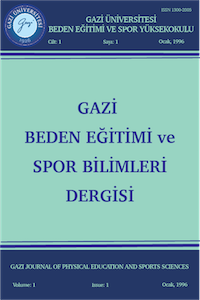COMPARISON OF SOME PHSIOLOGICAL CAPACITY AND ANTHROPOMETRIC STRUCTURE OF TURKISH AND RUSSIAN NATIONAL BOXING TEAMS
Öz
The
purpose of this study is to compare Russain and Turkish National Boxing Teams
considering some physiological capacity and anthropometric structures. In htis
study, there were 19 subjects from Turkish Boxing National Team and 17 subjects
from Russian national Boxing team. All subjects height, age weight, heart rate,
systolic and diastolic blood pressure, vertical jump, anaerobic power and
percent body fat were measured respectively. Their skinfolds (biceps, triceps,
subscapula, chest, suprailiac, abdominal, thigh), circumferences (head,neck, chest*
shoulder, abdomen, wrist), length measurement (upper arm, total arm, thigh,
calf and total length) and diameters (biacromial, wrist, chest and chest width),
were measured respectively, Then mean (X) and standart deviation (SD) of all
variables were compared between Turkish Boxing National Team and Russain
National Boxing Team. At the end of the research Mest was calculated for each
variable.
As
a result, the measurement parameter scores of ligth weihgt Turkish Boxing
National Team ami Russain National Boxing Team were found significantly
different in physiological parameters, flexibility (t= 2.99) and body fat % (t=8.12);
in diameter, biacromial (t=-3.49), chest width (t=-6.15) and chest depth
(t--2.71); in circumference, abdominal (t=-7.11) and calf (t= 13.00); in
length, total arm (t=-4.18), upper arm (t=8.70). forearm (4.63) and thigh
(t=952); in skinfold, subscapula (t=12.53), abdominal (t=-7.99), triceps
(t=-636), chest (t=-8.63), suprailiac (t--13.06), and thigh (t- -24.43). On the
other side, rest of the variables weren't found different from each other.
The
measurement parameter scores of middle weight Turkish Boxing National Team and
Russain National Boxing Team were found significantly different in
physiological parameters, flexibilit (t-4.21), body fat %(t=-7.16); in diameter,
biacromial (t--9.49) and chest (t=-8.00); in circumference, neck (t=-556),
abdominal (t=-2.84), shoulder (t=-4.54) and calf(t=8.42); in length, hand
(t=329), upper arm (t=5.64), forearm (t-3Ji5) and total leg (t=3.24); in
skinfold, abdominal (t=-7.99), biceps (t^-6.07), chest (t=-855), subscapula
(t=8J2), suprailiac (t=-8.85) and thigh (t~-17.!6). On the other side, rest of
the variables weren't found different from each other.
The
measurement parameter scores of heavy weight Turkish Boxing National Team and
Russain National Boxing Team were found significantly different in
physiological parameters, age (t-3.09). bod, fat % (t=-3.29); in diameter,
biacromial (t=-10.85) and chest (t=-6.06); in circumeference, head (t--2.19),
neck (t--3.49), chest (t=425), abdominal (t= 4,71), shoulder (t=-7.93) and calf
(t=2.90); in length, hand (t=9.80), total arm (t=I0.57), upper arm (t=I9.8V), forearm,
(t=13.56) and thigh (t=5.10); in skinfold, abdominal (t= -5.09), biceps (t--2.45),
chest (t~-4.l3). subscapula (t=2.80), suprailiac (t=-4.I8) and thigh (t--5.80).
On the other side, rest of the variables weren't found different from each
other.
Anahtar Kelimeler
Kaynakça
- Astrand, P.O, Rodahl, K. (1977). Textbook of Physiology, Third Edition, McGraw Hill Book Company, Toronto, 192-709.
- Bale, P. (1985). Relationship Among Physique, Strength, and Performance of Students. Journal of Sport Medicine, 25, 175-213.
- Baumgartner, Ted, A., Andrew, S. Jockson. (1975). Measurement for Evaluation in Physical Education. Houghton Mifflin Company, London, 175-213.
- Bompa, T.O. (1986). Theory and Methodology of Training. Dubuque, 240.
- Brozek, J., and Keys,A(1951). The evaluation of leanness-fatness in man. Norms and interrelationships. British Journal of Nutrition. 5, 194-206.
TÜRK RUS BOKS MİLLİ TAKIMLARININ BAZI FİZYOLOJİK KAPASİTE VE ANTROPOMETRİK YAPILARININ KARŞILAŞTIRILMASI
Öz
Bu
araştırmanın amacı Türk ve Rus Boks Milli Takımlarının bazı fizyolojik kapasite
ve antropometrik yapılarının karşılaştırılmasıdır. Çalışmaya katılan boksörler
kilolarına göre; hafif (50-60 kg), orta (60-70 kg) ve ağır (70-H2kg) sıklet
olarak 3 gruba bölündüler ve Türk Milli Takımından 19, Rus Milli Takımından 17
denek katıldı. Tüm deneklerin sırasıyla; yaş, vücut ağırlığı, boy, esneklik
(otur-uzan), sistolik-diastolik kan basıncı, dinlenme kalp atımları, dikey
sıçrama, vücut yağ yüzdeleri ve anaerobik güç ölçümleri alındı. Antropometrik
ölçüm olarak; skinfold, çevre, çap. uzunluk değişkenleri ölçüldü, bütün
değişkenlerin aritmetik ortalama, standart sapmaları ve t test analizleri
P<0.05 ve P<0.01 düzeyinde incelendi.
Sonuç
olarak Hafif Sıklet Türk ve Rus Boks Milli Takımları'nın fizyolojik ve
antropometrik değerlerinde bazı anlamlı farklılıklara rastlanmıştır. Bu
değişkenler sırası ile fizyolojik ölçümlerinde esneklik (otur-uzan) (t=2.99).
vücut yağ % (t=8.12); çap ölçümlerinde, biakromial (t=3.49), göğüs
çapı(t=-6.15), göğüs derinliği (t=-2.71); çevre ölçümlerinde, karın (t=-7.11),
baldır (t=J3.00), uzunluk ölçümlerinde, karın (t=-7.9. arka üst kol (t=-636).
göğüs (t= -8.63). subscapula (t-12.53) ve suprailiak (t=-13.06) değerlerinde
anlamlı fark bulunurken, diğer değişkenlerde anlamlı bir farka rastlanmamıştır.
Orta
sıklet Türk ve Rus Boks Milli Takımları'nın fizyolojik ve antropometrik
değerlerinde de bazı anlamlı farklılıklar bulunmuştur. Bu değişkenler sırası
ile fizyolojik ölçümlerde, esneklik (otur-uzan)(t=4.21), vücut yağ % (t=-3.29);
çap ölçümlerinde, biakromial (t=-4.71), omuz (t=-7.93), baldır (f=2.90);
uzunluk ölçümlerinde ise el (t-9.80), tüm kol (t=10.57), üst kol (t=19.89),
önkol (t=13.56), uyluk (t=5.10), skinfold ölçümlerinde karın (t=-5/)9). arka
üst kol (t=-2.45). göğüs (t--4.13), subscapulat (t-2J80), üst bacak; (t=-5A0)
ve suprailiak (t=-4.18) değerlerinde anlamlı fark bulunurken, diğer değişkenlerde
anlamlı bir farka rastlanmamıştır.
Sonuç
olarak; esnekliğin ve vücut yağ oranının düşük, gövdenin daha ince, kol ve
bacakların uzun olmasının boksta başarıda önemli kriterler olabileceğini söyleyebiliriz.
Anahtar Kelimeler
Kaynakça
- Astrand, P.O, Rodahl, K. (1977). Textbook of Physiology, Third Edition, McGraw Hill Book Company, Toronto, 192-709.
- Bale, P. (1985). Relationship Among Physique, Strength, and Performance of Students. Journal of Sport Medicine, 25, 175-213.
- Baumgartner, Ted, A., Andrew, S. Jockson. (1975). Measurement for Evaluation in Physical Education. Houghton Mifflin Company, London, 175-213.
- Bompa, T.O. (1986). Theory and Methodology of Training. Dubuque, 240.
- Brozek, J., and Keys,A(1951). The evaluation of leanness-fatness in man. Norms and interrelationships. British Journal of Nutrition. 5, 194-206.
Ayrıntılar
| Konular | Spor Hekimliği |
|---|---|
| Bölüm | Makaleler |
| Yazarlar | |
| Yayımlanma Tarihi | 12 Ocak 1999 |
| Gönderilme Tarihi | 15 Mart 2017 |
| Kabul Tarihi | 12 Kasım 1998 |
| Yayımlandığı Sayı | Yıl 1999 Cilt: 4 Sayı: 1 |
Gazi Beden Eğitimi ve Spor Bilimleri Dergisi yılda dört kez (Mart, Haziran, Eylül, Aralık) yayımlanan bilimsel ve hakemli bir dergidir.


